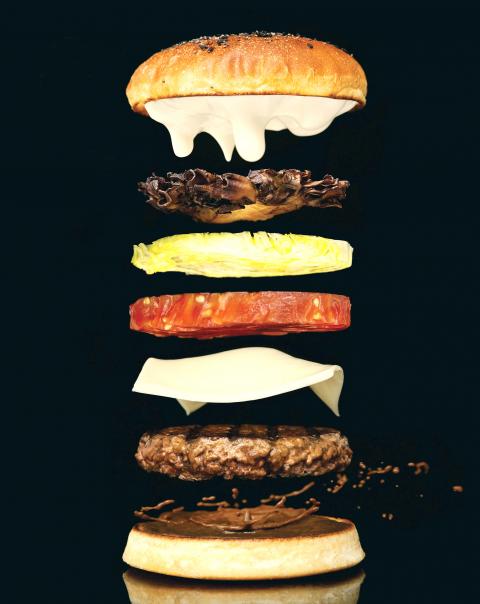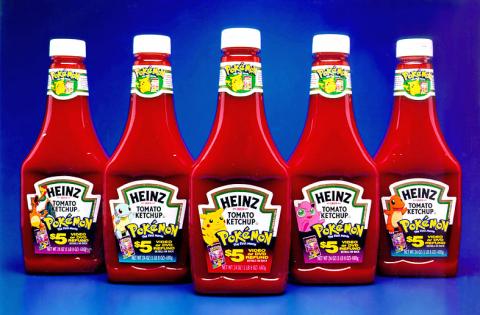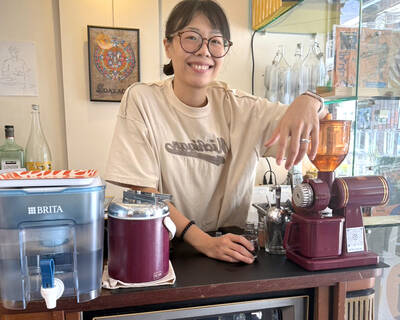The chef Jose Andres says that it’s time for America to face a hard truth, one that all of Alice Waters’ goat cheese salads and Thomas Keller’s fried chicken cannot change.
“Everyone else in the world still thinks of American food as ketchup,” said Andres, who was born in Spain but has been living and cooking in Washington for 20 years.
He said that European colleagues still tease him about finding success here, among diners whose palates are corrupted by ketchup. The low prestige of ketchup hits Andres hard.

Photo: Bloomberg
Now he is on a quest for redemption. He and a few other chefs and entrepreneurs are challenging the hegemony of the red, corn-syrup-sweetened product.
“It is time to embrace and celebrate ketchup, not be ashamed of it,” he said.
And so his new pop-up restaurant, America Eats Tavern, has a separate menu of traditional ketchups, made from local and foraged ingredients and served on everything from fried chicken to bison steak to hot dogs. (Some, it should be noted, consider ketchup on hot dogs an abomination.)

Photo: Bloomberg
The restaurant opened in June in the space that formerly housed Cafe Atlantico, and grew from an exhibition at the nearby National Archives that runs through January. What’s Cooking, Uncle Sam? illustrates the history of government influence on the American diet, from handwritten rations for Revolutionary War soldiers (500g of beef and bread per day) to the ill-starred 1981 proposal by the US Department of Agriculture to reclassify ketchup as a vegetable in federal school-lunch programs.
Last week, America Eats Tavern had eight ketchups on the menu and still more fermenting in the mind of Jorge Luis Hernandez, who leads Andres’ culinary research team. Hernandez said that in searching the archives, the team found dozens of ketchup recipes in tomes like Miss Beecher’s Domestic Receipt Book (1846) and The Virginia Housewife (1824).
“Today we think of ketchup as just one thing: Heinz, or Hunt’s, for those of us who grew up in the South,” he said.
But over the years, the term has been used for a variety of strongly seasoned condiments.
“We started making whortleberry and barberry and oyster ketchup from the original recipes,” Hernandez said, “and we were shocked by how diverse and modern the flavors were.” Indeed, the tart-sweet balance of the fruit ketchups, and the cold brininess of the oyster version (fresh oysters blended into a base of wine, butter, shallots and mace) could have come out of any of the professional kitchens in France where Andres first trained as a chef.
Some of the ketchups were red (cherry and spiceberry), one was made from tomatoes (yellow, from the greenmarket outside the restaurant’s door) and two (oyster and anchovy) were brightly fishy. They tasted of spices and fruit, of peppercorns and vinegar, but not particularly like the syrupy tomato blast that has come to represent America’s primary contribution to world cuisine (whether Americans like it or not).
“Why, as a society, have we let this diversity go away?” Andres lamented via cellphone from Spain — where, he said, it would be unthinkable to find just one version of a classic sauce like romesco. “Why would we go from a rainbow to black and white?”
American foodies and chefs generally dismiss ketchup, deeming it fit only for children and burgers.
The apotheosis of ketchup shame is the gastropub Father’s Office in Santa Monica, outside Los Angeles, a serious burger town where condiments, especially mayonnaise, are deeply loved. The chef Sang Yoon’s Office Burger, and its salty-sweet topping of bacon and caramelized onions, is the centerpiece of his menu. Yet since opening in 2000, he has refused to serve ketchup with it, or with anything else in the restaurant.
Many Angelenos remain irritated by what they see as the chef’s snobbery, and some have maintained a boycott.
“My wife would not go until this year, when I begged her to go with me on Father’s Day,” said Cesar Ramirez, who lives in Hacienda Heights, California. To appease her, he smuggled in some packets of Heinz and put it on the sweet-potato fries, then posted pictures of the contraband plate online. “I respect the integrity of the chef, but I also respect the power of ketchup because I can put it on anything, even vegetables, and my kids will eat it.”
Many chefs who take burgers seriously (now including Yoon, as he wrote in the Los Angeles Times last week) make their own ketchup, with “good” ingredients like fresh ginger, ripe figs and whole spices. But few have tried to make a Heinz-like product. (“It’s too dangerous to try to do that and not nail it,” Hernandez said.)
That has recently changed. From an undisclosed location in Lancaster County, Pennsylvania, two serious young entrepreneurs are working to undermine what they call “one of the last monopolies” in American food. “Heinz is not just the market leader but the market definer,” said Mark Ramadan, who started Sir Kensington’s Gourmet Scooping Ketchup last year with Scott Norton. It is the first alternative ketchup to be aggressively marketed to restaurant chefs and upscale hotel chains, and via Twitter.
If such a thing is possible, Sir Kensington’s is also the first ironic ketchup.
“There’s something absurd in the whole notion of gourmet ketchup,” Norton said. “‘All-natural,’ ‘farm-fresh,’ ‘local’ — all that stuff is great, but it doesn’t speak to us about ketchup.”
Instead of selling the virtues of the product, they sell a persona: An elusive top-hatted roue who tweets his location in cool locales and slips fetching little jars of ketchup to those in the know.
Sir Kensington’s, like other upscale versions such as Katchkie Ketchup and Stonewall Kitchens’ Country Ketchup, is less sweet and less salty than Heinz.
“The point of ketchup is the balance,” Norton said. “You want to taste the earthiness of tomatoes first, rather than the sweet sting of corn syrup.”
Even within the tomato ketchup category, the US once had dozens of regional brands. Mike Gassman, a lifelong ketchup fan, lives in Collinsville, Illinois, once home to a cannery that produced a chile-infused local ketchup called Brooks Brothers that was popular in the Midwest.
“The old folks still say they miss the smell of the tomatoes and the spices coming through town,” Gassman said. (Brooks Rich & Tangy Ketchup is now made in Canada.)
“Ketchup” has gradually taken over from “catsup,” a British spelling.
Ketchup was used on the British table long before tomatoes arrived there. It was described in print as early as 1690, having made its way to Europe either from China (the Cantonese ke-tsiap (茄 汁) means, roughly, “eggplant juice”) or from Malaysia (where the Malay word kecap referred to fermented fish sauce). Salty Indonesian soy sauce, tart tamarind chutneys and vinegary English sauces made with unripe walnuts have all been called by the name.
American ketchup was first made with whatever the settlers managed to harvest, flavored with the precious spices they brought with them: nutmegs, ginger, pepper. Ketchups were much thinner and spicier back then, and Hernandez has hewed closely to the original recipes for the America Eats ketchups.
“I think that we are currently using more mace than any restaurant in the world,” he said.
Ketchup became an institution because it was one of the first American packaged foods, according to Alice Kamps, curator of the National Archives exhibition.
“Early in the industrial food era, ketchup tended to be made from the scraps on the floor of the cannery, with red dye and flavorings” she said. “It was also prone to explode.”
In 1906, faced with increasing fatalities and public outrage, the US Congress passed the Pure Food and Drug Act, leading to the Food and Drug Administration. The Act particularly benefited a cannery in Pittsburgh owned by Henry John Heinz, which was the first to sterilize and bottle ketchup without the toxic preservatives then available.
According to Jessica Jackson, a spokeswoman for the company, Heinz has made many different ketchups since 1876. In 1910, its catalog touted walnut ketchup and mushroom ketchup (both flavored with anchovy juices) as well as “a new condimental table sauce,” mustard ketchup, which regrettably did not catch on.
But along with American power and influence, tomato ketchup spread worldwide in the 20th century, through western Europe (on baked beans and sausages), eastern Europe (on pizza) and back to Asia, whence it came.
“I first saw ketchup served in India in the late 1980s,” said the Indian-American chef Maya Kaimal, who, arriving from the US for a visit, was surprised to be served samosas with a side of ketchup. “It was treated like just another chutney or sauce.”
In Malaysia, ketchup is the main flavoring in the popular street noodle stir-fry mee goreng mamak. In Tokyo and Hong Kong, diners squeeze it onto spaghetti, waffles and tacos at all manner of “American” restaurants. Sweet ketchup with Indian spices is used in Germany for the weird but popular currywurst; and ketchup, amped up with garlic, has become a signature ingredient in Chinese-Indian hybrid dishes like Manchurian cauliflower. Kaimal said that the Indian relationship with ketchup inspired her to make a more fragrant version, with warm spices like cumin, cayenne and coriander seed.
Andres grew up with American ketchup and still uses it. “I mix mayonnaise, ketchup and brandy and a little bit of mustard,” he said. “This is a heck of a good sauce for seafood.”
CHERRY KETCHUP
Adapted from Jose Andres
Time: 45 minutes
680g cherries
2 tablespoons whole mace blades or 2 teaspoons ground mace
1 1/2 teaspoons black peppercorns
1 teaspoon dry yellow mustard
1 teaspoon whole cloves
3/4 teaspoon ground cinnamon
1/3 teaspoon ground nutmeg, preferably freshly grated
1 teaspoon kosher salt
1/4 to 1/2 cup apple cider vinegar, preferably unfiltered.
1. In a saucepan, combine the cherries with 1/2 cup water. Bring to a simmer over medium-low heat and cook until the cherries soften, 8 to 10 minutes. Let cool slightly, then pass the cooked cherries and their liquid through a food mill, or press them through a colander, to make a chunky juice.
2. In a clean saucepan, combine the juice with the spices and salt. Simmer over low heat until reduced by half, about 15 minutes, stirring often.
3. Add 1/4 cup vinegar and keep cooking until thick enough to coat the back of a spoon. Remove a bit of the ketchup, let cool and taste. Adjust salt, spices and vinegar until the flavor is sweet, spicy and tart. The ketchup will keep refrigerated in an airtight container for up to 2 weeks.
Yield: 1 cup.

Cheng Ching-hsiang (鄭青祥) turned a small triangle of concrete jammed between two old shops into a cool little bar called 9dimension. In front of the shop, a steampunk-like structure was welded by himself to serve as a booth where he prepares cocktails. “Yancheng used to be just old people,” he says, “but now young people are coming and creating the New Yancheng.” Around the corner, Yu Hsiu-jao (饒毓琇), opened Tiny Cafe. True to its name, it is the size of a cupboard and serves cold-brewed coffee. “Small shops are so special and have personality,” she says, “people come to Yancheng to find such treasures.” She

Late last month Philippines Foreign Affairs Secretary Theresa Lazaro told the Philippine Senate that the nation has sufficient funds to evacuate the nearly 170,000 Filipino residents in Taiwan, 84 percent of whom are migrant workers, in the event of war. Agencies have been exploring evacuation scenarios since early this year, she said. She also observed that since the Philippines has only limited ships, the government is consulting security agencies for alternatives. Filipinos are a distant third in overall migrant worker population. Indonesia has over 248,000 workers, followed by roughly 240,000 Vietnamese. It should be noted that there are another 170,000

Hannah Liao (廖宸萱) recalls the harassment she experienced on dating apps, an experience that left her frightened and disgusted. “I’ve tried some voice-based dating apps,” the 30-year-old says. “Right away, some guys would say things like, ‘Wanna talk dirty?’ or ‘Wanna suck my d**k?’” she says. Liao’s story is not unique. Ministry of Health and Welfare statistics show a more than 50 percent rise in sexual assault cases related to online encounters over the past five years. In 2023 alone, women comprised 7,698 of the 9,413 reported victims. Faced with a dating landscape that can feel more predatory than promising, many in

Former Chinese Nationalist Party (KMT) chairwoman Hung Hsiu-chu’s (洪秀柱) attendance at the Chinese Communist Party’s (CPP) “Chinese People’s War of Resistance Against Japanese Aggression and the World Anti-Fascist War” parade in Beijing is infuriating, embarrassing and insulting to nearly everyone in Taiwan, and Taiwan’s friends and allies. She is also ripping off bandages and pouring salt into old wounds. In the process she managed to tie both the KMT and the Democratic Progressive Party (DPP) into uncomfortable knots. The KMT continues to honor their heroic fighters, who defended China against the invading Japanese Empire, which inflicted unimaginable horrors on the